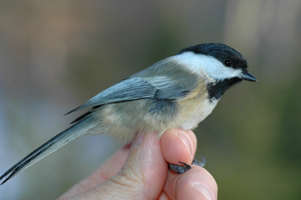In cold winter weather, black-capped chickadees may undergo regulated hypothermia, lowering their body temperature much below normal, to save lots of energy. They also store food and may roost communally in tree cavities, packing together to minimize heat loss.
Photo Credit: Geoffrey A. Hammerson
Poecile atricapillus
Common Name: black-capped chickadee
Animal Guild: Bird
Class > Order > Family: Aves > Passeriformes > Paridae
What does the species look like?
Black-capped chickadees have a black cap and throat, white cheeks, buffy (light brownish-yellow) sides; their wing feathers have white edges. Length 13 cm (5.1 inches), wingspan 21 cm (8.3 inches).
Where is the species found?
States & Provinces
AB, AK, AZ, BC, CA, CO, CT, DC, IA, ID, IL, IN, KS, MA, MB, MD, ME, MI, MN, MO, MT, NB, NC, ND, NE, NH, NJ, NL, NM, NS, NT, NV, NY, OH, ON, OR, PA, PE, QC, RI, SD, SK, TN, UT, VA, VT, WA, WI, WV, WY, YT
Distribution
This species is resident from western and central Alaska eastward across central and southern Canada to Newfoundland, and south to northwestern California, southern Utah, central New Mexico, Kansas, central Missouri, central Indiana, and northern New Jersey; and at higher elevations in the southern Appalachians. Black-capped chicakees wander south irregularly in winter.
They are found in deciduous and mixed deciduous/coniferous forests, willow thickets, cottonwood groves, old fields, and wooded suburban areas. They build nests in tree cavities, especially dead trees or rotten branches. Sometimes they nest in existing natural cavities, old woodpecker holes, bird boxes, or similar sites.
General Phenology and Life History
Nesting phenology varies geographically. These are the usual egg-laying times: late April to mid-June in Illinois; early May to mid-July in Massachusetts; late May to early June in Nova Scotia; mid-April to late June in Oregon; and mid-April to early July in Michigan. Black-capped chickadees incubate eggs for 12 to 13 days. The young fledge (are fully grown) 12 to 16 days after hatching, but are fed by their parents for an additional three to four weeks, until the young leave.
Which phenophases should I observe?
Do you see/hear...?
Activity
Live individuals More...
For abundance, enter the number of individual animals observed in this phenophase.
Feeding For abundance, enter the number of individual animals observed in this phenophase.
Fruit/seed consumption For abundance, enter the number of individual animals observed in this phenophase.
Insect consumption For abundance, enter the number of individual animals observed in this phenophase.
Calls or song For abundance, enter the number of individual animals observed in this phenophase.
Singing individuals For abundance, enter the number of individual animals observed in this phenophase.
Territorial individuals For abundance, enter the number of individual animals observed in this phenophase.
Reproduction
Courtship For abundance, enter the number of individual animals observed in this phenophase.
Mating For abundance, enter the number of individual animals observed in this phenophase.
Nest building For abundance, enter the number of individual animals observed in this phenophase.
Occupied nest For abundance, enter the number of individual animals observed in this phenophase.
Development
Nestlings For abundance, enter the number of individual animals observed in this phenophase.
Fledged young For abundance, enter the number of individual animals observed in this phenophase.
Dead individuals For abundance, enter the number of individual animals observed in this phenophase.
Dead nestlings or fledglings For abundance, enter the number of individual animals observed in this phenophase.
Method
Individuals at a feeding station For abundance, enter the number of individual animals observed in this phenophase.
What do these phenophases look like?
There is currently no photoguide available for this species. If you'd like help us create one, use the guidance document and species template provided here . Then send it via email to education@usanpn.org when it is complete.
